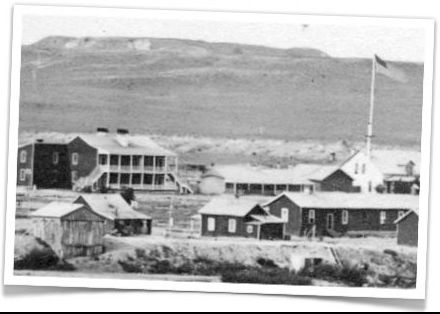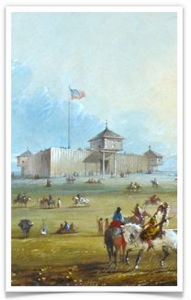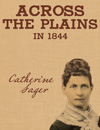Fort Laramie

ABOVE: Ft Laramie in 1868. BELOW: The original fort in the 1830s.
This military post was a welcome site for the pioneers--the first sign of civilization in six weeks. It was a unique respite from the endless wilderness.
Ft. Laramie marked the gateway to the Rocky Mountains. The emigrants were now one-third of the way to the Willamette. Here, they rested and regrouped. Some would give up the dream, turn around and go home. But most made the decision to push ahead.
 The fort had humble beginnings. In 1834, fur trader William Sublette built a wooden fortification here and called it Ft. William. There was no emigrant traffic then--Sublette's goal was trade with the local tribes. He offered alcohol and tobacco in return for buffalo robes.
The fort had humble beginnings. In 1834, fur trader William Sublette built a wooden fortification here and called it Ft. William. There was no emigrant traffic then--Sublette's goal was trade with the local tribes. He offered alcohol and tobacco in return for buffalo robes.
The fort was soon sold to the American Fur Company, and they rebuilt it as an adobe structure in 1841. The fur trade was in decline by then and fur traders would be gone from Ft. Laramie by 1849, when the army bought them out and embarked on a major expansion. Their charge: protect the emigrants from the increasingly hostile Sioux.
Perhaps the most important confrontation with the Sioux occurred in 1854 and became known as the Grattan Massacre. It began innocently enough when a single cow wandered away from an emigrant wagon train. When the cow showed up at a nearby Sioux village, the tribe promptly ate it. An aggressive Lt. Grattan and 28 men then left Ft. Laramie with a single objective--punish the Sioux. The Sioux recognized their error and offered a horse in return for the cow, but Grattan wasn't interested.
He ordered his men to fire on the tribe. The Sioux chief told his warriors to withhold retaliation. Grattan fired again and killed the chief. Strikes and counterstrikes escalated into all-out war and the battles continued for decades.As a result, Ft. Laramie grew into a large military complex.
There was only one building at Ft. Laramie that warranted a visit by the Oregon-bound emigrants--the post trader's store. It was the only reliable post office within 300 miles. Supplies could be purchased here too although prices were outrageously high. Tobbacco, for instance, that could be had for a nickel in St. Louis, cost a dollar here.
Emigrant/Author Francis Parkman:
"In one bargain, concluded in my presence, I calculated the profits that accrued to the fort--and found that at the lowest estimate they exceeded eighteen hundred percent."
Pioneer James Clyman:
"Groceries and Liquors exorbitantly high. For instance, Sugar $1.50 per pint or cupful. Flour $1 per pint."
Luckily, only a few of the emigrants needed to purchase supplies at Ft. Laramie; most wanted to sell their excess. Their overloaded wagons had become a greater and greater burden, but most held on until Ft. Laramie--in hopes they could earn some money for their extra supplies. But the fort trader wasn't buying.
So here the emigrants underwent wholesale dumping. The Trail near Ft. Laramie was littered with heirloom furniture, stoves and food. One emigrant saw ten tons of bacon by the side of the Trail. Despite the temptation, the emigrants did not pick up this valuable litter because weight was the great enemy of their wagons.





